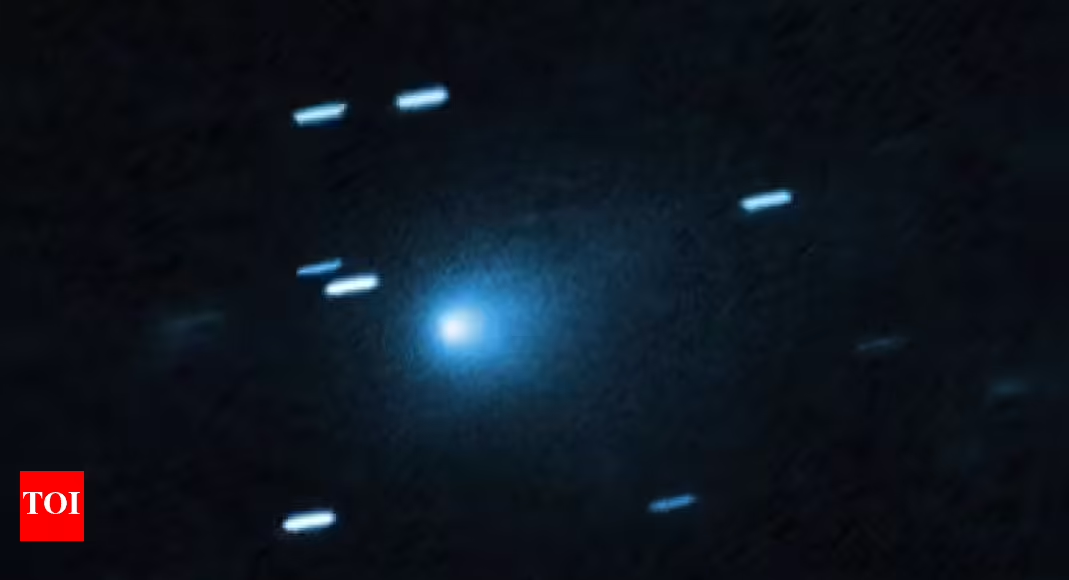Comet 3I/ATLAS: Rare interstellar visitor speeds through solar system at 130,000 mph, passing Mars and Jupiter | – The Times of India

In a rare astronomical event, comet 3I/ATLAS, an interstellar visitor, is passing through our solar system in 2025. Traveling at an astonishing speed of 130,000 mph (219,000 km/h), this comet originates from beyond our Sun, making it only the third confirmed interstellar object to enter the solar system. Its nucleus, less than 1 kilometer wide, is surrounded by a glowing coma of gas and dust, containing water ice, carbon dioxide, and carbon monoxide. On October 3, 2025, it will make its closest approach to Mars, allowing ESA and NASA spacecraft to observe it in detail. Later, it will pass near Jupiter during perihelion, offering a unique opportunity to study interstellar chemistry, comet activity, and planetary building blocks before it exits our solar system.
3I/ATLAS: Rare interstellar comet speeds through solar system at 130,000 mph
On July 1, 2025, astronomers using the NASA-funded ATLAS survey telescope in Chile identified a comet moving at remarkable speed. Named 3I/ATLAS, it is only the third confirmed interstellar object known to enter our solar system. Unlike ordinary comets bound to the Sun, 3I/ATLAS travels on a hyperbolic trajectory, confirming its origin outside our solar system. Its journey through the constellation Sagittarius at approximately 130,000 mph (219,000 km/h) makes it a rare cosmic visitor.The comet’s nucleus is estimated to be less than 1 kilometer across, surrounded by a cloud of gas and dust known as a coma. Observations from telescopes such as Hubble and the James Webb Space Telescope reveal a rich mix of water ice, carbon dioxide, carbon monoxide, and other gases. Its size and mass—potentially over 33 billion tons—make it larger than previous interstellar objects. While some speculation exists about unusual origins, the scientific consensus is that 3I/ATLAS is a natural interstellar comet.
Comet 3I/ATLAS makes close flyby of Mars: ESA and NASA spacecraft to observe up close
On October 3, 2025, comet 3I/ATLAS will make its closest approach to Mars, at a distance of approximately 30 million kilometers (18.6 million miles). This event provides an exceptional chance for Mars orbiters to directly observe the comet.ESA missions like Mars Express and ExoMars Trace Gas Orbiter are primed to collect detailed data on the comet’s structure and chemical composition. NASA’s Psyche spacecraft, currently en route to the asteroid 16 Psyche, will also capture valuable observations shortly after the Mars flyby.This encounter allows scientists to study the comet up close, as Earth-based observations during this period are limited due to its proximity to the Sun.Comet 3I/ATLAS approaches Jupiter: JUICE mission to study active perihelion phaseAfter passing Mars, 3I/ATLAS will head toward Jupiter, where ESA’s Jupiter Icy Moons Explorer (JUICE) will monitor it between November 2 and 25, 2025. During this time, the comet will reach perihelion, its closest point to the Sun.As the Sun’s heat energizes the comet, solar heating causes the comet to become highly active, releasing gas and dust that create its distinctive glowing coma and tail. This phase offers the best opportunity to measure the comet’s chemical composition and compare it with familiar solar system comets, potentially revealing new insights into planetary formation in other star systems.
Unique characteristics of 3I/ATLAS
Comet 3I/ATLAS exhibits properties that distinguish it from typical solar system comets:
- Hyper-speed trajectory: Traveling at 130,000 mph, confirming its interstellar origin.
- Small nucleus: Less than 1 kilometer in diameter, yet surrounded by an active coma.
- Complex composition: Contains carbon dioxide, carbon monoxide, and water ice, along with dust, providing clues about its parent star system.
- Limited Earth visibility: Its close proximity to the Sun during perihelion restricts safe Earth-based observations.
These characteristics make 3I/ATLAS a valuable natural laboratory for understanding the chemistry of distant star systems and the building blocks of planets.
Comet 3I/ATLAS to pass Venus, Mars, Earth, and Jupiter: ESA and NASA track interstellar visitor
From now until March 2026, 3I/ATLAS will swing past Venus, Mars, Earth, and Jupiter before leaving the solar system permanently. Its closest approach to Earth will be roughly 1.8 AU (about 170 million miles) in December 2025, posing no threat to our planet.ESA and NASA are actively preparing observations. Mars orbiters and NASA’s Mars Reconnaissance Orbiter (using the HiRISE camera) will attempt high-resolution imaging, while JUICE will continue monitoring the comet near Jupiter. These coordinated efforts ensure scientists capture data throughout its journey, despite Earth-based observational limitations. Comet 3I/ATLAS provides a rare opportunity to explore interstellar chemistry and planetary formation. By analyzing the gases and dust in its tail, scientists hope to determine if other star systems share the same building blocks of planets and possibly life. Comparisons with solar system comets may reveal exotic materials or chemical processes previously unknown to astronomers.This comet is more than a fleeting visitor—it represents a direct link to distant star systems, offering unique insights into the conditions and materials that shape worlds beyond our own.
Global space agencies track interstellar comet 3I/ATLAS to unlock galactic insights
Space agencies and astronomers around the world are closely monitoring 3I/ATLAS, capturing its passage using spacecraft and telescopes. The European Space Agency leverages missions around Mars and Jupiter to maintain continuous tracking when Earth-based instruments lose sight. Meanwhile, NASA spacecraft supplement these observations, ensuring a comprehensive dataset for scientific analysis.Also Read | NASA warns! 44-foot Massive asteroid 2025 TC speeding past Earth today at 58,100 km/h; how safe are we really
var _mfq = window._mfq || [];
_mfq.push([“setVariable”, “toi_titan”, window.location.href]);
!(function(f, b, e, v, n, t, s) {
function loadFBEvents(isFBCampaignActive) {
if (!isFBCampaignActive) {
return;
}
(function(f, b, e, v, n, t, s) {
if (f.fbq) return;
n = f.fbq = function() {
n.callMethod ? n.callMethod(…arguments) : n.queue.push(arguments);
};
if (!f._fbq) f._fbq = n;
n.push = n;
n.loaded = !0;
n.version = ‘2.0’;
n.queue = [];
t = b.createElement(e);
t.async = !0;
t.defer = !0;
t.src = v;
s = b.getElementsByTagName(e)[0];
s.parentNode.insertBefore(t, s);
})(f, b, e, ‘https://connect.facebook.net/en_US/fbevents.js’, n, t, s);
fbq(‘init’, ‘593671331875494’);
fbq(‘track’, ‘PageView’);
};
function loadGtagEvents(isGoogleCampaignActive) {
if (!isGoogleCampaignActive) {
return;
}
var id = document.getElementById(‘toi-plus-google-campaign’);
if (id) {
return;
}
(function(f, b, e, v, n, t, s) {
t = b.createElement(e);
t.async = !0;
t.defer = !0;
t.src = v;
t.id = ‘toi-plus-google-campaign’;
s = b.getElementsByTagName(e)[0];
s.parentNode.insertBefore(t, s);
})(f, b, e, ‘https://www.googletagmanager.com/gtag/js?id=AW-877820074’, n, t, s);
};
function loadSurvicateJs(allowedSurvicateSections = []){
const section = window.location.pathname.split(‘/’)[1]
const isHomePageAllowed = window.location.pathname === ‘/’ && allowedSurvicateSections.includes(‘homepage’)
const ifAllowedOnAllPages = allowedSurvicateSections && allowedSurvicateSections.includes(‘all’);
if(allowedSurvicateSections.includes(section) || isHomePageAllowed || ifAllowedOnAllPages){
(function(w) {
function setAttributes() {
var prime_user_status = window.isPrime ? ‘paid’ : ‘free’ ;
var geoLocation = window?.geoinfo?.CountryCode ? window?.geoinfo?.CountryCode : ‘IN’ ;
w._sva.setVisitorTraits({
toi_user_subscription_status : prime_user_status,
toi_user_geolocation : geoLocation
});
}
if (w._sva && w._sva.setVisitorTraits) {
setAttributes();
} else {
w.addEventListener(“SurvicateReady”, setAttributes);
}
var s = document.createElement(‘script’);
s.src=”https://survey.survicate.com/workspaces/0be6ae9845d14a7c8ff08a7a00bd9b21/web_surveys.js”;
s.async = true;
var e = document.getElementsByTagName(‘script’)[0];
e.parentNode.insertBefore(s, e);
})(window);
}
}
window.TimesApps = window.TimesApps || {};
var TimesApps = window.TimesApps;
TimesApps.toiPlusEvents = function(config) {
var isConfigAvailable = “toiplus_site_settings” in f && “isFBCampaignActive” in f.toiplus_site_settings && “isGoogleCampaignActive” in f.toiplus_site_settings;
var isPrimeUser = window.isPrime;
var isPrimeUserLayout = window.isPrimeUserLayout;
if (isConfigAvailable && !isPrimeUser) {
loadGtagEvents(f.toiplus_site_settings.isGoogleCampaignActive);
loadFBEvents(f.toiplus_site_settings.isFBCampaignActive);
loadSurvicateJs(f.toiplus_site_settings.allowedSurvicateSections);
} else {
var JarvisUrl=”https://jarvis.indiatimes.com/v1/feeds/toi_plus/site_settings/643526e21443833f0c454615?db_env=published”;
window.getFromClient(JarvisUrl, function(config){
if (config) {
const allowedSectionSuricate = (isPrimeUserLayout) ? config?.allowedSurvicatePrimeSections : config?.allowedSurvicateSections
loadGtagEvents(config?.isGoogleCampaignActive);
loadFBEvents(config?.isFBCampaignActive);
loadSurvicateJs(allowedSectionSuricate);
}
})
}
};
})(
window,
document,
‘script’,
);
[title_words_as_hashtags



